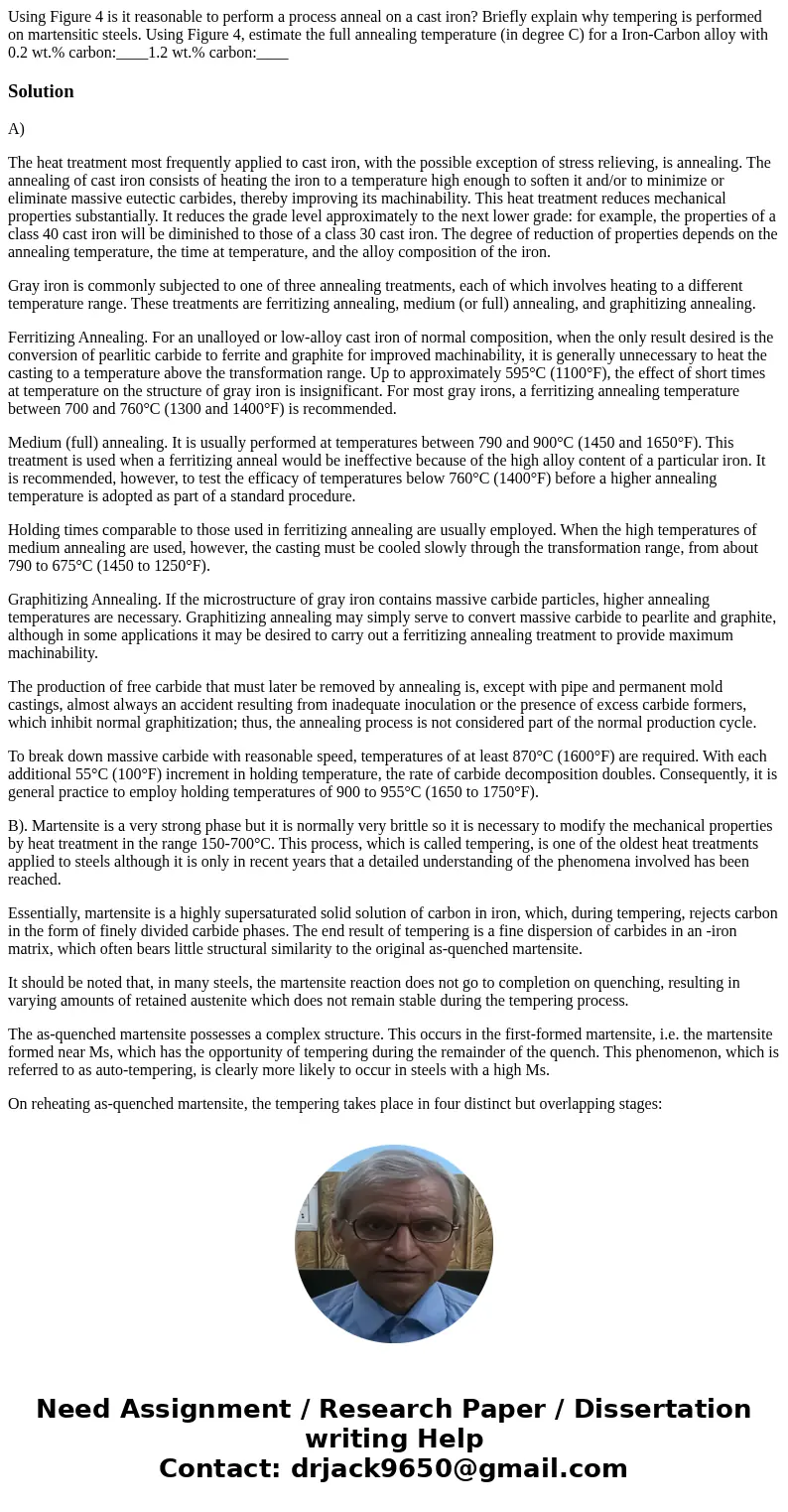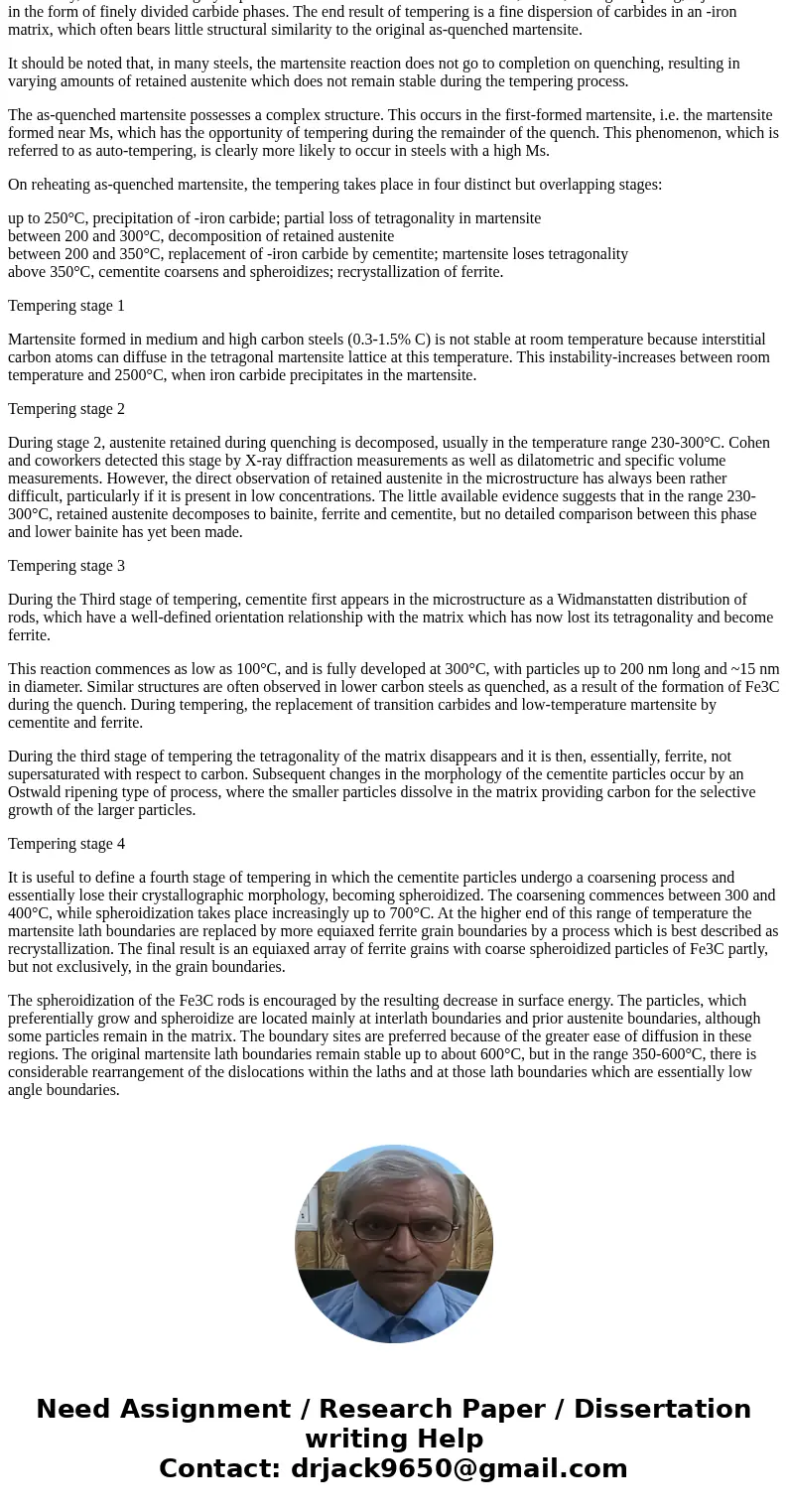Using Figure 4 is it reasonable to perform a process anneal
Solution
A)
The heat treatment most frequently applied to cast iron, with the possible exception of stress relieving, is annealing. The annealing of cast iron consists of heating the iron to a temperature high enough to soften it and/or to minimize or eliminate massive eutectic carbides, thereby improving its machinability. This heat treatment reduces mechanical properties substantially. It reduces the grade level approximately to the next lower grade: for example, the properties of a class 40 cast iron will be diminished to those of a class 30 cast iron. The degree of reduction of properties depends on the annealing temperature, the time at temperature, and the alloy composition of the iron.
Gray iron is commonly subjected to one of three annealing treatments, each of which involves heating to a different temperature range. These treatments are ferritizing annealing, medium (or full) annealing, and graphitizing annealing.
Ferritizing Annealing. For an unalloyed or low-alloy cast iron of normal composition, when the only result desired is the conversion of pearlitic carbide to ferrite and graphite for improved machinability, it is generally unnecessary to heat the casting to a temperature above the transformation range. Up to approximately 595°C (1100°F), the effect of short times at temperature on the structure of gray iron is insignificant. For most gray irons, a ferritizing annealing temperature between 700 and 760°C (1300 and 1400°F) is recommended.
Medium (full) annealing. It is usually performed at temperatures between 790 and 900°C (1450 and 1650°F). This treatment is used when a ferritizing anneal would be ineffective because of the high alloy content of a particular iron. It is recommended, however, to test the efficacy of temperatures below 760°C (1400°F) before a higher annealing temperature is adopted as part of a standard procedure.
Holding times comparable to those used in ferritizing annealing are usually employed. When the high temperatures of medium annealing are used, however, the casting must be cooled slowly through the transformation range, from about 790 to 675°C (1450 to 1250°F).
Graphitizing Annealing. If the microstructure of gray iron contains massive carbide particles, higher annealing temperatures are necessary. Graphitizing annealing may simply serve to convert massive carbide to pearlite and graphite, although in some applications it may be desired to carry out a ferritizing annealing treatment to provide maximum machinability.
The production of free carbide that must later be removed by annealing is, except with pipe and permanent mold castings, almost always an accident resulting from inadequate inoculation or the presence of excess carbide formers, which inhibit normal graphitization; thus, the annealing process is not considered part of the normal production cycle.
To break down massive carbide with reasonable speed, temperatures of at least 870°C (1600°F) are required. With each additional 55°C (100°F) increment in holding temperature, the rate of carbide decomposition doubles. Consequently, it is general practice to employ holding temperatures of 900 to 955°C (1650 to 1750°F).
B). Martensite is a very strong phase but it is normally very brittle so it is necessary to modify the mechanical properties by heat treatment in the range 150-700°C. This process, which is called tempering, is one of the oldest heat treatments applied to steels although it is only in recent years that a detailed understanding of the phenomena involved has been reached.
Essentially, martensite is a highly supersaturated solid solution of carbon in iron, which, during tempering, rejects carbon in the form of finely divided carbide phases. The end result of tempering is a fine dispersion of carbides in an -iron matrix, which often bears little structural similarity to the original as-quenched martensite.
It should be noted that, in many steels, the martensite reaction does not go to completion on quenching, resulting in varying amounts of retained austenite which does not remain stable during the tempering process.
The as-quenched martensite possesses a complex structure. This occurs in the first-formed martensite, i.e. the martensite formed near Ms, which has the opportunity of tempering during the remainder of the quench. This phenomenon, which is referred to as auto-tempering, is clearly more likely to occur in steels with a high Ms.
On reheating as-quenched martensite, the tempering takes place in four distinct but overlapping stages:
up to 250°C, precipitation of -iron carbide; partial loss of tetragonality in martensite
between 200 and 300°C, decomposition of retained austenite
between 200 and 350°C, replacement of -iron carbide by cementite; martensite loses tetragonality
above 350°C, cementite coarsens and spheroidizes; recrystallization of ferrite.
Tempering stage 1
Martensite formed in medium and high carbon steels (0.3-1.5% C) is not stable at room temperature because interstitial carbon atoms can diffuse in the tetragonal martensite lattice at this temperature. This instability-increases between room temperature and 2500°C, when iron carbide precipitates in the martensite.
Tempering stage 2
During stage 2, austenite retained during quenching is decomposed, usually in the temperature range 230-300°C. Cohen and coworkers detected this stage by X-ray diffraction measurements as well as dilatometric and specific volume measurements. However, the direct observation of retained austenite in the microstructure has always been rather difficult, particularly if it is present in low concentrations. The little available evidence suggests that in the range 230-300°C, retained austenite decomposes to bainite, ferrite and cementite, but no detailed comparison between this phase and lower bainite has yet been made.
Tempering stage 3
During the Third stage of tempering, cementite first appears in the microstructure as a Widmanstatten distribution of rods, which have a well-defined orientation relationship with the matrix which has now lost its tetragonality and become ferrite.
This reaction commences as low as 100°C, and is fully developed at 300°C, with particles up to 200 nm long and ~15 nm in diameter. Similar structures are often observed in lower carbon steels as quenched, as a result of the formation of Fe3C during the quench. During tempering, the replacement of transition carbides and low-temperature martensite by cementite and ferrite.
During the third stage of tempering the tetragonality of the matrix disappears and it is then, essentially, ferrite, not supersaturated with respect to carbon. Subsequent changes in the morphology of the cementite particles occur by an Ostwald ripening type of process, where the smaller particles dissolve in the matrix providing carbon for the selective growth of the larger particles.
Tempering stage 4
It is useful to define a fourth stage of tempering in which the cementite particles undergo a coarsening process and essentially lose their crystallographic morphology, becoming spheroidized. The coarsening commences between 300 and 400°C, while spheroidization takes place increasingly up to 700°C. At the higher end of this range of temperature the martensite lath boundaries are replaced by more equiaxed ferrite grain boundaries by a process which is best described as recrystallization. The final result is an equiaxed array of ferrite grains with coarse spheroidized particles of Fe3C partly, but not exclusively, in the grain boundaries.
The spheroidization of the Fe3C rods is encouraged by the resulting decrease in surface energy. The particles, which preferentially grow and spheroidize are located mainly at interlath boundaries and prior austenite boundaries, although some particles remain in the matrix. The boundary sites are preferred because of the greater ease of diffusion in these regions. The original martensite lath boundaries remain stable up to about 600°C, but in the range 350-600°C, there is considerable rearrangement of the dislocations within the laths and at those lath boundaries which are essentially low angle boundaries.


 Homework Sourse
Homework Sourse